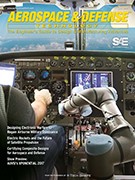Article
Advanced simulation using the digital twin to achieve electromagnetic compatibility and electrification management in a modern UAS
2022-01-13
The aerospace industry is facing immense challenges due to increased design complexity and higher levels of integration, particularly in the electrification of aircraft. These challenges can easily impact program cost and product time to market. System electrification and electromagnetic compatibility (EMC) have become critical issues today. In the context of 3D electromagnetics, EMC electromagnetic compatibility ensures the original equipment manufacturer (OEM) that radiated emissions from various electronic devices, such as avionics or the entire aircraft for that matter, do not interfere with other electronic products onboard the aircraft.


